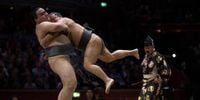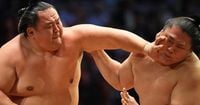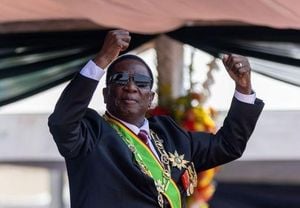The Royal Albert Hall, the iconic London venue known for hosting legendary acts such as The Beatles, Queen, and Adele, added another historic chapter to its storied legacy this week. For just the second time in history, and the first since 1991, the Grand Sumo Tournament brought the spectacle and tradition of Japan’s national sport to the heart of England. From October 13 to October 19, 2025, 40 of the world’s top-ranked rikishi—sumo’s elite athletes—descended on the capital, transforming the concert hall into a vibrant arena of ancient rituals, thunderous clashes, and unforgettable moments.
The anticipation had been building for weeks, and by the time the opening night arrived, a sell-out crowd of 5,000 fans filled every seat, with many more tuning in via BBC Sport’s live broadcasts and digital platforms. Spectators came from across Europe, eager to witness a sporting event rarely seen outside Japan. Even the warning signs for those seated on ornate cushions close to the ring—alerting them to the risk of being squashed by a flying rikishi—did little to deter the excitement.
Sumo’s arrival in London was no small feat. The logistics were as grand as the sport itself. The combined weight of the 40 participating rikishi was a staggering 6.6 tonnes (7.4 U.S. tons), necessitating two separate flights from Japan. Their Kensington hotel went through roughly 75kg of rice per day to fuel their legendary appetites, with each wrestler consuming between 10,000 and 20,000 calories daily. Reports even surfaced of a noodle shortage, as the athletes sought their beloved Chanko Nabe stew after grueling training sessions that could burn up to 10,000 calories in a single morning.
The dohyō—the sacred sumo ring—was painstakingly constructed in the center of the Royal Albert Hall. Built by hand over three days using traditional methods, the 6.7-metre-wide structure was formed from clay and rice-straw bales, tamped into shape with beer bottles. The tsuriyane, a roof designed to resemble Japan’s Ise Shrine, hung above the ring, emphasizing the event’s deep roots in Shinto tradition. Before the first bout, the Dohyo-Matsuri purification ceremony was performed, with salt, rice, sake, seaweed, and dried squid offered at the ring’s center. This ancient ritual, followed by prayers and purification, set the stage for the battles to come.
The opening ceremony was a spectacle in itself. The rikishi, dressed in elaborate Kesho-Mawashi aprons, entered in two groups—east and west—and were introduced one by one to the captivated crowd. The atmosphere was electric as the wrestlers performed their muscle-draining leg stomps, clapped their hands to summon the divine, and flung salt to purify the ring. The crowd, a mix of seasoned sumo fans and curious newcomers, responded with respectful hushes during the rituals and raucous cheers during the action.
Each night featured 20 fast and furious bouts, none lasting more than a minute. The rules were simple: force your opponent out of the ring or make any part of his body except his feet touch the ground. But the execution was anything but. With 82 recognized kimarite—winning techniques—on display, the bouts showcased not just brute strength, but also speed, balance, and dazzling technique. The initial charge at the tachiai, when two giants collided at the center, has been likened to being hit by a car at 30mph. The sound of flesh slapping against flesh echoed through the hall, making for a visceral, unforgettable experience.
Among the standout competitors was Onosato Daiki, the grand champion and one of sumo’s two Yokozuna present in London. Onosato, weighing in at 191kg, was not only a dominant force in the ring but also a crowd favorite, seen around London enjoying local food, sightseeing, and even riding e-bikes. The smallest rikishi, Fujinokawa, weighed 117kg, but as the opening night proved, size wasn’t everything. Quick-footed Tobizaru, at 135kg, toppled the much larger Shonannoumi, weighing 181kg, in a stunning display of agility that had the crowd roaring.
As the tournament progressed, the drama only intensified. On October 18, Hoshoryu, another Yokozuna, delivered a commanding performance against Takayasu, securing a comfortable win and joining Onosato and Tobizaru with a perfect 4-0 record heading into the final. According to BBC Sport, “Hoshoryu shows why he’s a Yokozuna! Comfortable win against Takayasu.” This was no small feat—Takayasu had previously beaten Hoshoryu nine times out of twelve, but the tables had turned, with Hoshoryu now winning their last two encounters. The stage was set for a thrilling conclusion.
Another highlight saw Tobizaru defeat Kirishima with a perfectly executed shitatenage (underarm throw), also advancing to 4-0. The crowd’s support was palpable, with BBC Sport reporting, “Huge cheer from the crowd as Tobizaru beats Kirishima by shitatenage and goes 4-0. Can he go all the way in tomorrow’s final?!” Meanwhile, Tamawashi, the 40-year-old veteran, proved age was just a number, overpowering Abi with a classic oshidashi (frontal push out). “Nobody’s going to beat the 40-year-old in a slapping match,” one commentator quipped, as the audience erupted in applause.
Beyond the ring, the tournament was a cultural phenomenon. The rikishi became celebrities in London, their daily outings in kimonos and sandals turning heads wherever they went. The event dominated news bulletins and social media, while BBC Sport’s coverage allowed fans across the UK to catch up on the week’s action for up to 30 days after the event.
The impact of the Grand Sumo Tournament extended far beyond the Royal Albert Hall. Sumo’s popularity in the UK is on the rise, with around 100 amateur clubs now competing nationwide, up from just a handful a year ago. Sonny Bell, founder of the London Sumo Club, told reporters, “The sport has been booming in the past year.”
As the final approaches, excitement is at fever pitch. Hoshoryu, Onosato, and Tobizaru are all unbeaten, setting up a dramatic showdown. The action resumes with BBC’s build-up coverage from 13:00 BST on October 19, and fans are eager to see who will emerge victorious. Whatever the outcome, the 2025 Grand Sumo Tournament in London has already cemented its place as one of the most memorable sporting events of the year—an unforgettable fusion of tradition, athleticism, and international camaraderie.
With the final bout looming, all eyes remain fixed on the dohyō, where history is about to be made once again at the Royal Albert Hall. Stay tuned as the giants of sumo prepare for one last clash in London’s hallowed arena.





